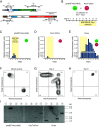Genetic crosses within and between species of Cryptosporidium
- PMID: 38147547
- PMCID: PMC10769859
- DOI: 10.1073/pnas.2313210120
Genetic crosses within and between species of Cryptosporidium
Abstract
Parasites and their hosts are engaged in reciprocal coevolution that balances competing mechanisms of virulence, resistance, and evasion. This often leads to host specificity, but genomic reassortment between different strains can enable parasites to jump host barriers and conquer new niches. In the apicomplexan parasite Cryptosporidium, genetic exchange has been hypothesized to play a prominent role in adaptation to humans. The sexual lifecycle of the parasite provides a potential mechanism for such exchange; however, the boundaries of Cryptosporidium sex are currently undefined. To explore this experimentally, we established a model for genetic crosses. Drug resistance was engineered using a mutated phenylalanyl tRNA synthetase gene and marking strains with this and the previously used Neo transgene enabled selection of recombinant progeny. This is highly efficient, and genomic recombination is evident and can be continuously monitored in real time by drug resistance, flow cytometry, and PCR mapping. Using this approach, multiple loci can now be modified with ease. We demonstrate that essential genes can be ablated by crossing a Cre recombinase driver strain with floxed strains. We further find that genetic crosses are also feasible between species. Crossing Cryptosporidium parvum, a parasite of cattle and humans, and Cryptosporidium tyzzeri a mouse parasite resulted in progeny with a recombinant genome derived from both species that continues to vigorously replicate sexually. These experiments have important fundamental and translational implications for the evolution of Cryptosporidium and open the door to reverse- and forward-genetic analysis of parasite biology and host specificity.
Keywords: Apicomplexa; diarrheal disease; genetic cross; parasite; sex.
Conflict of interest statement
Competing interests statement:The authors declare no competing interest.
Figures





Update of
-
Genetic crosses within and between species of Cryptosporidium.bioRxiv [Preprint]. 2023 Aug 4:2023.08.04.551960. doi: 10.1101/2023.08.04.551960. bioRxiv. 2023. Update in: Proc Natl Acad Sci U S A. 2024 Jan 2;121(1):e2313210120. doi: 10.1073/pnas.2313210120. PMID: 37577700 Free PMC article. Updated. Preprint.
References
-
- Kotloff K. L., The burden and etiology of diarrheal illness in developing countries. Pediatr. Clin. North Am. 64, 799–814 (2017). - PubMed
-
- Kotloff K. L., et al. , Burden and aetiology of diarrhoeal disease in infants and young children in developing countries (the Global Enteric Multicenter Study, GEMS): A prospective, case-control study. Lancet (London, England) 382, 209–222 (2013). - PubMed
-
- O’connor R. M., et al. , Cryptosporidiosis in patients with HIV/AIDS. AIDS 25, 549–560 (2011). - PubMed
MeSH terms
Grants and funding
LinkOut - more resources
Full Text Sources
Medical

